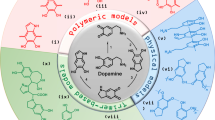Abstract
Based on the analysis of the regularities of the interaction of dopamine borates and dimethyl silyl ether, two alternative mechanisms of their oxidation for the purpose of obtaining polydopamine as a promising product for the creation of new and efficient adhesive compounds for joining biological tissues are proposed. An explanation of the presence of a threshold concentration of dopamine in the reaction system which provides the formation of polydopamine is proposed.




Similar content being viewed by others
REFERENCES
H. Lee, S. M. Dellatore, W. M. Miller, and P. B. Messersmith, “Mussel-inspired surface chemistry for multifunctional coatings,” Science 318 (5849), 426–430 (2007).
D. R. Dreyer, D. J. Miller, B. D. Freeman, D. R. Paul, and C. W. Bielawski, “Perspectives on poly(dopamine),” Chem. Sci. 4 (10), 3796–3802 (2013).
J. Liebscher, R. Mrowczynski, H. A. Scheidt, C. Filip, N. D. Hădade, R. Turcu, A. Bende, and S. Beck, “Structure of polydopamine: A never-ending story?,” Langmuir 29 (33), 10539–10548 (2013).
E. Faure, C. Falentin-Daudre, C. Jerome, J. Lyskawa, D. Fournier, P. Woisel, and C. Detrembleur, “Catechols as versatile platforms in polymer chemistry,” Prog. Polym. Sci. 38 (1), 236–270 (2013).
J. H. Waite, “Nature’s underwater adhesive specialist,” Int. J. Adhes. Adhes. 7 (1), 9–14 (1987).
J. H. Waite and X. Qin, “Polyphosphoprotein from the adhesive pads of Mytilus edulis,” Biochemistry 40 (9), 2887–2893 (2001).
J. H. Waite and M. L. Tanzer, “The bioadhesive of Mytilus byssus: A protein containing L-dopa,” Biochem. Biophys. Res. Commun. 96 (4), 1554–1561 (1980).
C. Zhang, L. Gong, L. Xiang, Y. Du, W. Hu, H. Zeng, and Z.-K. Xu, “Deposition and adhesion of polydopamine on the surfaces of varying wettability,” ACS Appl. Mater. Interfaces 9 (36), 30943–30950 (2017).
I. S. Kwon and C. Bettinger, “Polydopamine nanostructures as biomaterials for medical applications,” J. Mater. Chem. B 6, 6895–6903 (2018).
C. M. Vogels and S. A. Westcott, “Arylspiroboronate esters: From lithium batteries to wood preservatives to catalysis,” Chem. Soc. Rev. 40 (3), 1446–1458 (2011).
A. Schneider, J. Hemmerle, M. Allais, J. Didierjean, M. Michel, M. d’Ischia, and V. Ball, “Boric acid as an efficient agent for the control of polydopamine self-assembly and surface properties,” ACS Appl. Mater. Interfaces 10 (9), 7574–7580 (2018).
E. Herlinger, R. F. Jameson, and W. Linert, “Spontaneous autoxidation of dopamine,” J. Chem. Soc., Perkin Trans. 2, 259–263 (1995).
Funding
This work was financially supported by the Ministry of Science and Higher Education of the Russian Federation as part of a state assignment within project no. FSSM-2020-0004.
Author information
Authors and Affiliations
Corresponding author
Additional information
Translated by E. Boltukhina
Rights and permissions
About this article
Cite this article
Varankin, A.V., Artyukhov, A.A., Shtil’man, M.I. et al. The Mechanism of the Initial Stage of Synthesis of Polydopamine. Polym. Sci. Ser. D 15, 30–34 (2022). https://doi.org/10.1134/S1995421222010245
Received:
Revised:
Accepted:
Published:
Issue Date:
DOI: https://doi.org/10.1134/S1995421222010245




